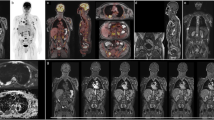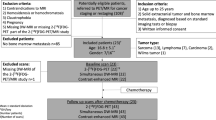Abstract
Objectives
Mixing diagnostic and prognostic data provided by whole-body MRI (WB-MRI) and 2-18F-fluorodeoxyglucose (2-[18F]FDG) positron emission tomography (2-[18F]FDG-PET) from a single simultaneous imaging technique for newly diagnosed multiple myeloma (NDMM) initial workup seems attractive. However, to date, the published data are scarce and this possibility has not been fully explored. In this prospective study, we aimed to explore the diagnostic performance and added clinical value of WB-2-[18F]FDG-PET/MRI imaging in NDMM.
Methods
All patients with confirmed NDMM at the Nantes University Hospital were prospectively enrolled in this study and underwent WB-2-[18F]FDG-PET/MRI imaging on a 3-T Biograph mMR before receiving treatment. Before imaging, they were considered either as symptomatic or as smoldering MM (SMM). Diagnostic performance of global WB-2-[18F]FDG-PET/MRI imaging, as well as PET and MRI separately for FL and diffuse BMI detection, was assessed and compared in each group. PET-based (maximal standardized uptake value, SUVmax) and MRI-based (mean apparent diffusion coefficient value, ADCmean) quantitative features were collected for FL/para-medullary disease (PMD)/bone marrow and were compared.
Results
A total of 52 patients were included in this study. PET and MRI were equally effective at detecting patients with FL (69% vs. 75%) and with diffuse BMI (62% for both) in the symptomatic MM group. WB-2-[18F]FDG-PET/MRI imaging detected FL in 22% of patients with SMM (with a higher diagnostic performance for MRI), resulting in a significant impact on clinical management in this population. SUVmax and ADCmean quantitative features were weakly or not correlated.
Conclusions
WB-2-[18F]FDG-PET/MRI could represent the next-generation imaging modality for MM.
Key Points
• Whole-body 2-[18F]FDG-PET/MRI imaging detected at least one focal bone lesion in 75% of patients with symptomatic multiple myeloma, and PET and MRI were equally effective at identifying patients with a focal bone lesion.
• Whole-body 2-[18F]FDG-PET/MRI imaging detected a focal bone lesion in 22% of patients with smoldering multiple myeloma (with a higher diagnostic performance for MRI).
• MRI had a significant impact on clinical management of smoldering multiple myeloma.



Similar content being viewed by others
Abbreviations
- 2-[18F]FDG:
-
2-18F-fluorodeoxyglucose
- ADC:
-
Apparent diffusion coefficient
- BMI:
-
Bone marrow involvement
- CT:
-
Computed tomography
- DCE:
-
Dynamic contrast enhanced
- DWI:
-
Diffusion-weighted imaging
- EMD:
-
Extra-medullary disease
- FL:
-
Focal bone lesion
- IMWG:
-
International Myeloma Working Group
- MDE:
-
Myeloma defining event
- MM:
-
Multiple myeloma
- MRAC:
-
Magnetic resonance attenuation correction
- NDMM:
-
Newly diagnosed multiple myeloma
- PET:
-
Positron emission tomography
- PMD:
-
Para-medullary disease
- ROC:
-
Receiver-operating characteristic
- ROI:
-
Region of interest
- SMM:
-
Smoldering multiple myeloma
- SUVmax :
-
Maximal standardized uptake value
- WB-2-[18F]FDG-PET/MRI:
-
Whole-body 2-18F-fluorodeoxyglucose-positron emission tomography coupled with magnetic resonance imaging
References
Rajkumar SV, Dimopoulos MA, Palumbo A et al (2014) International Myeloma Working Group updated criteria for the diagnosis of multiple myeloma. Lancet Oncol 15:e538–e548
Hillengass J, Usmani S, Rajkumar SV et al (2019) International Myeloma Working Group consensus recommendations on imaging in monoclonal plasma cell disorders. Lancet Oncol 20(6):e302–e312
Hillengass J, Fechtner K, Weber M-A et al (2010) Prognostic significance of focal lesions in whole-body magnetic resonance imaging in patients with asymptomatic multiple myeloma. J Clin Oncol 28(9):1606–10
Kastritis E, Moulopoulos LA, Terpos E, Koutoulidis V, Dimopoulos MA (2014) The prognostic importance of the presence of more than one focal lesion in spine MRI of patients with asymptomatic (smoldering) multiple myeloma. Leukemia 28(12):2402–2403
Zamagni E, Nanni C, Gay F et al (2016) 18F-FDG PET/CT focal, but not osteolytic, lesions predict the progression of smoldering myeloma to active disease. Leukemia 30(2):417–422
Moreau P, Attal M, Caillot D et al (2017) Prospective evaluation of magnetic resonance imaging and [18F] fluorodeoxyglucose positron emission tomography-computed tomography at diagnosis and before maintenance therapy in symptomatic patients with multiple myeloma included in the IFM/DFCI 2009 trial: results of the IMAJEM study. J Clin Oncol 35(25):2911–2918
Zamagni E, Patriarca F, Nanni C et al (2011) Prognostic relevance of 18-F FDG PET/CT in newly diagnosed multiple myeloma patients treated with up-front autologous transplantation. Blood 118(23):5989–5995
Bartel TB, Haessler J, Brown TLY et al (2009) F18-fluorodeoxyglucose positron emission tomography in the context of other imaging techniques and prognostic factors in multiple myeloma. Blood 114(10):2068–2076
Abe Y, Ikeda S, Kitadate A et al (2019) Low hexokinase-2 expression-associated false-negative (18) F-FDG PET/CT as a potential prognostic predictor in patients with multiple myeloma. Eur J Nucl Med Mol Imaging 46(6):1345–1350
Jamet B, Morvan L, Nanni C et al (2021) Random survival forest to predict transplant-eligible newly diagnosed multiple myeloma outcome including FDG-PET radiomics: a combined analysis of two independent prospective European trials. Eur J Nucl Med Mol Imaging 48(4):1005–1015
Benaniba L, Tessoulin B, Trudel S et al (2019) The MYRACLE protocol study: a multicentric observational prospective cohort study of patients with multiple myeloma. BMC Cancer 19(1):855
Messiou C, Hillengass J, Delorme S et al (2019) Guidelines for acquisition, interpretation, and reporting of whole-body MRI in myeloma: myeloma response assessment and diagnosis system (MY-RADS). Radiology 291(1):5–13
Dutoit J, Vanderkerken M, Verstraete KL (2013) Value of whole body MRI and dynamic contrast enhanced MRI in the diagnosis, follow-up and evaluation of disease activity and extent in multiple myeloma. Eur J Radiol 82(9):1444–1452
Nanni C, Zamagni E, Versari A et al (2016) Image interpretation criteria for FDG PET/CT in multiple myeloma: a new proposal from an Italian expert panel. IMPeTUs (Italian Myeloma criteria for PET USe). Eur J Nucl Med Mol Imaging 43(3):414–421
Messiou C, Collins DJ, Morgan VA, Desouza NM (2011) Optimising diffusion weighted MRI for imaging metastatic and myeloma bone disease and assessing reproducibility. Eur Radiol 21(8):1713–1718
Kyle RA, Gertz MA, Witzig TE et al (2003) Review of 1027 patients with newly diagnosed multiple myeloma. Mayo Clin Proc 78:21–33
Westerland O, Amlani A, Kelly-Morland C et al (2021) Comparison of the diagnostic performance and impact on management of 18F-FDG PET/CT and whole-body MRI in multiple myeloma. Eur J Nucl Med Mol Imaging 48(8):2558–2565
Burns R, Mulé S, Blanc-Durand P et al (2021) Optimization of whole-body 2-[18F]FDG-PET/MRI imaging protocol for the initial staging of patients with myeloma. Eur Radiol. 32(5):3085–3096
Rasche L, Angtuaco E, McDonald JE et al (2017) Low expression of hexokinase-2 is associated with false-negative FDG-positron emission tomography in multiple myeloma. Blood 130(1):304
Aljama MA, Sidiqi MH, Buadi FK et al (2018) Utility and prognostic value of 18F-FDG positron emission tomography-computed tomography scans in patients with newly diagnosed multiple myeloma. Am J Hematol 93(12):1518–1523
Jung S-H, Kwon SY, Min J-J et al (2019) 18F-FDG PET/CT is useful for determining survival outcomes of patients with multiple myeloma classified as stage II and III with the revised international staging system. Eur J Nucl Med Mol Imaging 46(1):107–115
Michaud-Robert AV, Zamagni E, Carlier T et al (2020) Glucose metabolism quantified by SUVmax on baseline FDG-PET/CT predicts survival in newly diagnosed multiple myeloma patients: combined harmonized analysis of two prospective phase III trials. Cancers (Basel) 12(9):2532
Cavo M, Terpos E, Nanni C et al (2017) International Myeloma Working Group. Review Role of 18F-FDG PET/CT in the diagnosis and management of multiple myeloma and other plasma cell disorders: a consensus statement by the International Myeloma Working Group. Lancet Oncol 18:e206-2017
Moulopoulos LA, Dimopoulos MA, Christoulas D et al (2010) Diffuse MRI marrow pattern correlates with increased angiogenesis, advanced disease features and poor prognosis in newly diagnosed myeloma treated with novel agents. Leukemia 24:1206–1212
Paschali A, Panagiotidis E, Triantafyllou T et al (2021) A proposed index of diffuse bone marrow [18F]-FDG uptake and PET skeletal patterns correlate with myeloma prognostic markers, plasma cell morphology, and response to therapy. Eur J Nucl Med Mol Imaging 48(5):1487–1497
Funding
This work has been supported in part by grants from the French National Agency for Research called “Investissements d’Avenir” IRON Labex n°ANR-11-LABX-0018–01 and INCa-DGOS-Inserm_12558 (SIRIC ILIAD).
Author information
Authors and Affiliations
Corresponding author
Ethics declarations
Guarantor
The scientific guarantor of this publication is Francoise Kraeber-Bodere (FKB), head of Nantes University Hospital’s department of nuclear medicine.
Conflict of interest
The authors declare no competing interests.
Statistics and biometry
No complex statistical methods were necessary for this paper.
Informed consent
Written informed consent was obtained from all subjects (patients) in this study.
Ethical approval
Institutional review board approval was obtained.
Cohort overlap
Some study subjects or cohorts have previously been reported in Benaniba L, Tessoulin B, Trudel S, et al The MYRACLE protocol study: a multicentric observational prospective cohort study of patients with multiple myeloma. BMC Cancer. 2019;19(1):855.
Methodology
• prospective
• diagnostic study
• performed at one institution
Additional information
Publisher's note
Springer Nature remains neutral with regard to jurisdictional claims in published maps and institutional affiliations.
Supplementary information
Below is the link to the electronic supplementary material.
Rights and permissions
Springer Nature or its licensor (e.g. a society or other partner) holds exclusive rights to this article under a publishing agreement with the author(s) or other rightsholder(s); author self-archiving of the accepted manuscript version of this article is solely governed by the terms of such publishing agreement and applicable law.
About this article
Cite this article
Jamet, B., Carlier, T., Bailly, C. et al. Hybrid simultaneous whole-body 2-[18F]FDG-PET/MRI imaging in newly diagnosed multiple myeloma: first diagnostic performance and clinical added value results. Eur Radiol 33, 6438–6447 (2023). https://doi.org/10.1007/s00330-023-09593-1
Received:
Revised:
Accepted:
Published:
Issue Date:
DOI: https://doi.org/10.1007/s00330-023-09593-1




